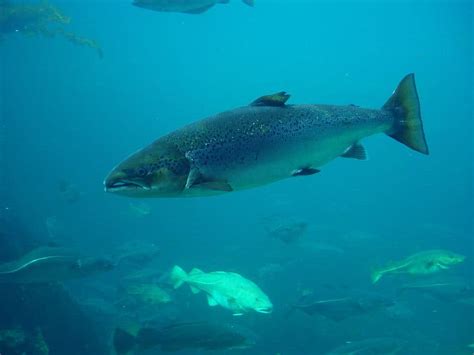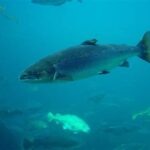
A newly confirmed case of breeding between invasive armored catfish species in Florida is raising alarms among scientists, who warn that these hybrid “super species” pose a significant threat to the state’s aquatic ecosystems. The interbreeding could lead to offspring with enhanced survival traits, potentially exacerbating the already detrimental impacts of armored catfish on native fish populations and habitat.
Florida’s aquatic ecosystems face a growing menace as confirmed hybridization between different species of armored catfish raises fears of a new, more resilient “super species.” Scientists are urgently warning that this interbreeding could lead to the development of offspring with enhanced survival capabilities, further threatening the state’s native fish and aquatic habitats. Armored catfish, originally introduced through the aquarium trade, have already established themselves as a destructive invasive species in Florida’s waterways. Now, the potential for hybridization adds a new layer of complexity to the challenge of managing these harmful invaders.
According to a report recently highlighted, the confirmed breeding between different armored catfish species has prompted serious concerns among ecologists and conservationists. These catfish, belonging to the Loricariidae family, are native to South America and were introduced to Florida’s waters through aquarium releases. Their hardy nature and lack of natural predators have allowed them to thrive, causing significant ecological damage. Their habits include burrowing into banks, which leads to erosion and habitat destruction. Moreover, they compete with native fish species for food and resources, and their presence has been linked to declines in local fish populations.
Dr. Nathan Burkhead, a research fish biologist with the U.S. Geological Survey (USGS), emphasized the seriousness of the threat. “The hybridization of these species could result in offspring that are more adaptable and resilient than either parent species,” he stated. This adaptability could translate into increased tolerance to environmental stressors, faster growth rates, or enhanced reproductive capabilities, making the hybrid offspring even more difficult to control.
The concern is not merely theoretical. Scientists have observed instances of interbreeding in the wild and have confirmed the genetic mixing of different armored catfish species. The implications of this hybridization are far-reaching, potentially leading to a cascade of negative effects on Florida’s already stressed aquatic ecosystems.
One of the primary concerns is the potential for increased invasiveness. Hybrid offspring may inherit traits from both parent species, combining the most detrimental characteristics into a single, highly competitive organism. For example, if one species is particularly adept at burrowing and another is highly tolerant of low oxygen levels, the hybrid offspring could possess both of these traits, allowing it to thrive in a wider range of habitats and outcompete native species more effectively.
The ecological consequences of armored catfish invasion are already substantial. These fish are known to alter aquatic habitats by digging nests in the banks of rivers and lakes, contributing to erosion and habitat degradation. Their feeding habits can also disrupt food webs, impacting the populations of other fish, invertebrates, and even aquatic plants. The hybridization of these species could exacerbate these impacts, leading to further declines in biodiversity and ecosystem health.
Managing invasive species is a complex and challenging task, requiring a multifaceted approach that includes prevention, early detection, and rapid response. In the case of armored catfish, prevention efforts focus on educating aquarium owners about the risks of releasing non-native species into the wild. Early detection involves monitoring waterways for the presence of armored catfish and identifying areas where they are becoming established. Rapid response measures may include targeted removal efforts, such as trapping or electrofishing, to control populations and prevent further spread.
However, the hybridization of armored catfish adds a new level of difficulty to these management efforts. If hybrid offspring are more resilient and adaptable than their parent species, traditional control methods may be less effective. New strategies may be needed to address the unique challenges posed by these hybrid “super species.” This could involve developing species-specific control methods, targeting reproductive behaviors, or even exploring the use of biological control agents.
The situation in Florida serves as a cautionary tale for other regions facing the threat of invasive species. The introduction of non-native species can have profound and irreversible consequences for ecosystems and economies. Preventing the introduction and spread of invasive species is crucial for protecting biodiversity, maintaining ecosystem health, and safeguarding natural resources.
The hybridization of armored catfish in Florida underscores the importance of ongoing research and monitoring to understand the dynamics of invasive species and their impacts on native ecosystems. By studying the genetic makeup, behavior, and ecological interactions of these hybrid catfish, scientists can develop more effective strategies for managing their populations and mitigating their negative effects.
The challenge of managing invasive species requires a collaborative effort involving government agencies, research institutions, conservation organizations, and the public. By working together, these stakeholders can develop and implement comprehensive strategies to prevent the introduction and spread of invasive species, protect native ecosystems, and preserve biodiversity for future generations.
The problem extends beyond just the ecological impact. The economic consequences of invasive species are significant, with costs associated with control efforts, habitat restoration, and losses to fisheries and tourism. Addressing the threat of invasive species requires a long-term commitment and sustained investment in research, management, and education.
One potential avenue for control lies in understanding the genetic vulnerabilities of the hybrid species. By identifying specific genes or genetic pathways that are essential for their survival or reproduction, scientists could develop targeted control methods that disrupt these processes. This approach could involve the use of gene editing technologies or the development of species-specific biocontrol agents.
Another area of research focuses on the ecological interactions of armored catfish and their impact on native species. By understanding how these invasive fish compete with native species for resources, alter habitats, and disrupt food webs, scientists can develop more effective strategies for mitigating their negative effects. This could involve restoring degraded habitats, managing water flows, or even introducing native predators or competitors to help control armored catfish populations.
Education and outreach are also essential components of any invasive species management strategy. By raising public awareness about the risks of releasing non-native species into the wild, and by providing information about how to identify and report invasive species, individuals can play an active role in preventing their spread. Aquarium owners, in particular, need to be educated about the responsible disposal of unwanted fish and plants.
The situation in Florida highlights the need for a proactive approach to invasive species management. Rather than waiting for invasive species to become established and cause widespread damage, it is crucial to take steps to prevent their introduction and spread in the first place. This includes implementing stricter regulations on the importation and sale of non-native species, enhancing border controls to prevent the introduction of new invaders, and developing rapid response plans to address new incursions quickly and effectively.
The confirmed hybridization of armored catfish in Florida serves as a stark reminder of the complex and evolving challenges posed by invasive species. Addressing this threat requires a sustained commitment to research, management, and education, as well as a collaborative effort involving government agencies, research institutions, conservation organizations, and the public. By working together, we can protect our native ecosystems and preserve biodiversity for future generations.
The continued proliferation of armored catfish also underscores the global nature of the invasive species problem. With increased international trade and travel, the risk of introducing non-native species to new environments is greater than ever before. Addressing this challenge requires international cooperation and the development of global strategies for preventing the spread of invasive species.
The situation also brings to light the ethical considerations surrounding the introduction of non-native species. While some introductions may be intentional, such as for aquaculture or ornamental purposes, others are accidental, resulting from ballast water discharge or the escape of animals from captivity. Regardless of the cause, the introduction of non-native species can have devastating consequences for ecosystems and economies.
The hybridization of armored catfish in Florida is not an isolated incident. Similar cases of hybridization have been documented in other invasive species around the world. This suggests that hybridization may be a common mechanism by which invasive species adapt to new environments and increase their invasiveness. Understanding the genetic and ecological factors that promote hybridization is crucial for developing effective management strategies.
The long-term consequences of armored catfish hybridization in Florida are still uncertain. However, the potential for the emergence of more resilient and adaptable “super species” is a cause for serious concern. Addressing this threat requires a sustained commitment to research, management, and education, as well as a collaborative effort involving all stakeholders. Only through a coordinated and comprehensive approach can we hope to protect Florida’s aquatic ecosystems from the harmful effects of these invasive fish.
The success of any invasive species management strategy depends on the availability of accurate and timely information. This requires ongoing monitoring of waterways, as well as the development of effective methods for detecting and identifying invasive species. Citizen science initiatives can play a valuable role in this effort, by engaging volunteers in monitoring and reporting the presence of invasive species.
The hybridization of armored catfish in Florida also highlights the importance of considering the potential for unintended consequences when introducing non-native species. Even species that are initially considered to be benign can become invasive under certain circumstances. Thorough risk assessments should be conducted before introducing any non-native species, and strict regulations should be in place to prevent their release into the wild.
The challenges posed by invasive species are complex and multifaceted, requiring a holistic and integrated approach. This includes addressing the underlying causes of invasion, such as habitat degradation and climate change, as well as implementing effective management strategies to control established populations. By working together, we can protect our native ecosystems and preserve biodiversity for future generations.
The economic impact of invasive species often goes unnoticed, but it can be substantial. Costs associated with control efforts, habitat restoration, and losses to fisheries and tourism can add up to billions of dollars annually. Investing in prevention and early detection can be far more cost-effective than trying to control established populations of invasive species.
The hybridization of armored catfish in Florida serves as a case study for the challenges and complexities of invasive species management. By learning from this experience, we can develop more effective strategies for preventing and controlling invasive species around the world. This requires a sustained commitment to research, management, and education, as well as a collaborative effort involving government agencies, research institutions, conservation organizations, and the public.
The ongoing research into armored catfish hybridization also highlights the importance of genetic analysis in understanding the dynamics of invasive species. By studying the genetic makeup of these fish, scientists can gain insights into their origins, dispersal patterns, and evolutionary adaptations. This information can be used to develop more targeted and effective control strategies.
The need for public awareness and education cannot be overstated. Many people are unaware of the risks associated with releasing non-native species into the wild. By raising awareness about this issue, we can encourage responsible behavior and prevent the introduction of new invasive species. Aquarium owners, in particular, need to be educated about the proper disposal of unwanted fish and plants.
The hybridization of armored catfish in Florida is a symptom of a larger problem: the increasing homogenization of the world’s ecosystems. As humans move species around the globe, we are disrupting natural patterns of biodiversity and creating opportunities for invasive species to thrive. Addressing this challenge requires a fundamental shift in our thinking about how we manage and interact with the natural world.
The long-term success of any invasive species management strategy depends on the development of sustainable solutions. This includes finding ways to control invasive species without harming native species or damaging the environment. It also includes addressing the underlying causes of invasion, such as habitat degradation and climate change. By adopting a sustainable approach, we can protect our native ecosystems and preserve biodiversity for future generations.
The confirmed hybridization of armored catfish in Florida underscores the urgency of addressing the invasive species problem. The potential for the emergence of more resilient and adaptable “super species” is a serious threat to our native ecosystems. By working together, we can develop and implement effective strategies to prevent the introduction and spread of invasive species, protect our natural resources, and preserve biodiversity for future generations.
Frequently Asked Questions (FAQ) about Armored Catfish Hybridization in Florida:
1. What are armored catfish and why are they a problem in Florida?
Armored catfish, belonging to the Loricariidae family, are native to South America and were introduced to Florida’s waters through aquarium releases. They are considered an invasive species because they have no natural predators, reproduce rapidly, and cause significant ecological damage. They burrow into banks, leading to erosion, compete with native fish for food and resources, and disrupt aquatic habitats. As Dr. Nathan Burkhead from the USGS notes, “The hybridization of these species could result in offspring that are more adaptable and resilient than either parent species,” exacerbating their invasiveness.
2. What does the confirmed breeding/hybridization of armored catfish mean for Florida’s ecosystems?
The confirmed hybridization of different armored catfish species means that these invasive fish are now interbreeding, potentially creating hybrid offspring with enhanced survival traits. This could lead to a “super species” that is even more adaptable, resilient, and difficult to control than the parent species. This intensifies the threat to native fish populations, aquatic habitats, and overall ecosystem health in Florida. The hybrids could combine detrimental traits from both parent species, such as enhanced burrowing ability and increased tolerance to low oxygen levels, allowing them to thrive in a wider range of habitats and outcompete native species more effectively.
3. How are these “super species” potentially more harmful than the original invasive armored catfish?
These hybrid “super species” are potentially more harmful because they could inherit the most detrimental characteristics from both parent species. This could include increased tolerance to environmental stressors, faster growth rates, enhanced reproductive capabilities, and a combination of harmful behaviors like burrowing and resource competition. These enhanced traits would make them more difficult to control and more effective at disrupting native ecosystems. As Dr. Burkhead explains, their adaptability allows them to thrive and spread more rapidly.
4. What is being done to manage or control the armored catfish population in Florida, and how will the hybridization affect these efforts?
Current management efforts include prevention through education, early detection through monitoring, and rapid response measures like trapping and electrofishing. The hybridization of armored catfish adds a new layer of complexity to these efforts, as traditional control methods may be less effective against the more resilient hybrid offspring. New strategies may be needed, such as species-specific control methods, targeting reproductive behaviors, or exploring biological control agents. Increased funding for research and management is crucial to address this evolving threat.
5. What can the public do to help prevent further spread of armored catfish and other invasive species in Florida?
The public can play a crucial role in preventing the further spread of armored catfish and other invasive species by:
- Never releasing aquarium fish or plants into the wild. This is the primary pathway for the introduction of armored catfish and other non-native species.
- Reporting sightings of armored catfish or other unusual aquatic species to the Florida Fish and Wildlife Conservation Commission (FWC) or other relevant authorities.
- Educating themselves and others about the risks of invasive species and the importance of responsible pet ownership.
- Supporting conservation organizations and initiatives that work to manage and control invasive species.
- Participating in citizen science programs that monitor waterways for invasive species.
- Advocating for stricter regulations on the importation and sale of non-native species.
The hybridization of armored catfish serves as a stark warning about the dangers of releasing non-native species into the environment and the importance of proactive management strategies. Public awareness and participation are essential for protecting Florida’s unique and valuable aquatic ecosystems.









